
Fast, affordable Internet access for all.
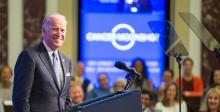
With the $14.2 billion Affordable Connectivity Program (ACP) on track to run out of funds by spring/early summer 2024, finally there is a request from the White House to extend funding for the program that over 21 million housholds now rely on to help pay for high-speed Internet service.
Last week, the Biden administration formally asked Congress for another $6 billion to extend the program through November 2024, joining a chorus of public interest groups (including AARP) calling on Congress to replenish the rapidly depleting fund.
(According to our calculations, an additional $6 billion would not fund the program through December 2024 as the White House said. It would fund the program through the end of November 2024. It would take $6.9B to get through the end of December).
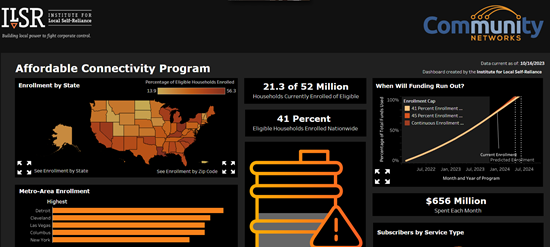
First established with the passage of the Infrastructure Investment and Jobs Act (IIJA) in 2021 as part of the Biden administration’s “Internet for All” initiative, the ACP – currently administered by the Federal Communications Commission (FCC) – provides income-eligible households with a $30 monthly subsidy ($75 per month for those living on Tribal lands) to pay for their Internet service bill. The program also provides a one-time $100 benefit to go towards the purchase of an Internet-connected device such as a laptop or tablet.
“Without this funding, tens of millions of people would lose this benefit and would no longer be able to afford high-speed Internet service without sacrificing other necessities,” the White House said in a statement, echoing the sentiment of broadband-for-all proponents across the nation as well as a bipartisan group of federal lawmakers who recently wrote a letter in support of further ACP funding to House and Senate leaders.
Long Term Funding Needed, Solution Remains Elusive
Currently, 21.3 million households are enrolled in the program, though upwards of 52 million households qualify for the benefit.
While digital equity advocates rightly celebrate the White House request for additional funding as a national effort is underway to boost ACP enrollment, leading digital inclusion organizations – such as the National Digital Inclusion Alliance (NDIA) – have also been advocating for a more permanent funding solution, possibly through reform of the Universal Services Fund.
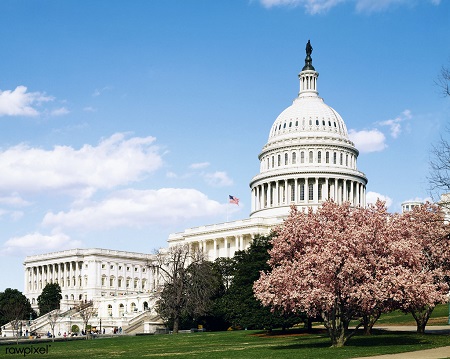
A permanent funding solution is vital especially considering that the United States has among the highest prices for broadband service of any developed nation in the world.
And while the infrastructure bill in general, and ACP in particular, does little to address the root causes of the broadband affordability crisis (e.g. lack of competition in a market dominated by monopoly incumbents), it is an important immediate solution to ensure that low-income households are not left on the wrong side of the digital divide in areas where broadband is available.
Of course, predicting how the ACP funding request will play out and what kind of compromises might be involved in a deeply partisan Congress is hard to gauge.
Hopefully, the GOP-led House of Representatives, which has called for deep cuts in domestic spending, will see the ACP as, not just another welfare program for low-income Americans, but an important part of the business plan for providers looking to build new networks in sparsely populated rural communities.
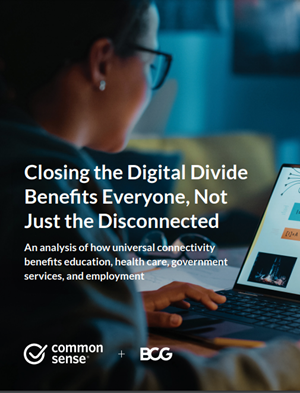
For independent providers to invest in rural networks where it is most expensive to build – and where a significant portion of the subscriber base cannot afford service – the ACP can make the difference in whether newly built networks will be financially sustainable or not, especially when it comes to the sustainability of Tribal networks.
The implications the ACP has in attracting private (and public) investment is further buttressed by a recent report, "Closing the Digital Divide Benefits Everyone, Not Just the Disconnected," published by Common Sense and the Boston Consulting Group (BCG). It makes the case that in addition to providing low-income households some short-term relief from pricey Internet bills, the ACP can also provide an economic incentive for ISPs to invest in unserved and underserved communities by increasing the return on investment (ROI) in areas that have previously been considered unprofitable.
Avoiding the Broadband Elephant in the Room
Still, should Congress grant the Biden White House request to extend the program, it won’t resolve the long term funding question, nor does it address the structural issues behind the high-cost of Internet service.
As we have previously written:
“Giving money to regional monopolies to temporarily lower the high prices they created through a sustained, multi-decade assault on competition isn’t genuinely fixing the underlying problem of broadband affordability, one of the top obstacles to expanding access and adoption.”
“The FCC rarely embraces policies or penalties that seriously threaten regional monopoly power, has failed to accurately map broadband access, has struggled to maintain a modern, ambitious definition of acceptable broadband access, and is routinely absent when it comes to advocating for the interests of community-owned broadband alternatives…”
“Political and policy rhetoric about the ‘digital divide’ often excludes solutions for the kind of harmful regional monopolization and industry consolidation that makes it difficult for smaller broadband competitors to survive.”
“ILSR studies have consistently shown how subsidies alone aren’t capable of addressing the root cause(s) of broadband inequity. Real solutions have to address concentrated monopoly power and its impact on competition. While programs like the ACP are hugely beneficial for struggling Americans, they remain a band-aid for a much deeper problem.”
“A more equitable and sustainable path forward requires developing policies that take direct aim at monopoly power, as well as supporting the more than 900 communities driving popular, locally-owned broadband alternatives (though even in communities where costs are reasonable or deemed as widely ‘affordable,’ there will likely remain a subset of any community who will need some form of subsidy to pay for service).”
“Eliminating a program currently providing aid to 20 million struggling households without first addressing the real cause of high broadband prices would be a painful disservice to Americans long trapped on the wrong side of the digital divide.”
Community-Owned Broadband Addresses Affordability Head-On
Increasingly, local communities are coming to realize the link between competition and affordability and therefore have come to favor a community broadband approach in which local governments, cooperatives, or nonprofit providers build and own network infrastructure, viewing the service more like a utility than a for-profit venture hungry for a quick return on investment.
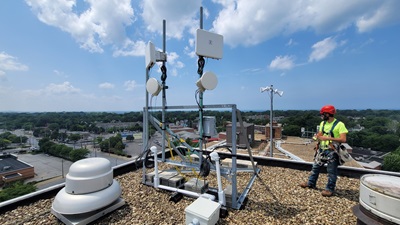
In Cleveland, as we reported here, the city opted to award $20 million of its American Rescue Plan funds to the Cleveland-based digital equity non-profit DigitalC, which is building a fixed wireless broadband network capable of providing symmetrical 100 Megabit per second (Mbps) service for $18 a month.
And in Chattanooga – home to the celebrated municipal broadband network, EPB Fiber – over 15,000 low-income students in that city are getting free fiber Internet service at home for a decade through HCS EdConnect, which was established before the ACP even existed.
While permanently funding ACP is vital and necessary, if we are going to achieve universal access to broadband, affordable to everyone, eventually lawmakers will have to honestly address the monopoly question and seek to create the conditions for meaningful competition in the broadband market.
Header image of President Biden courtesy of Eric Haynes, Attribution-NonCommercial-NoDerivs 4.0 International
Inline image of wireless network install in Cleveland courtesy of DigitalC
